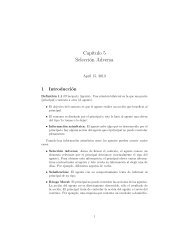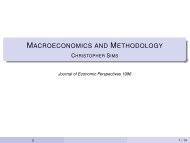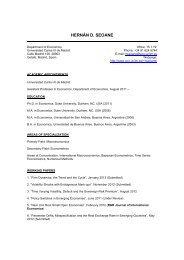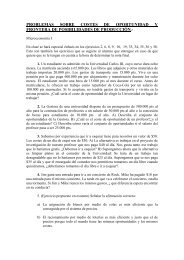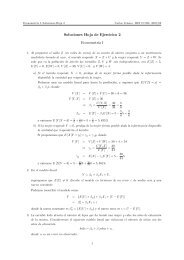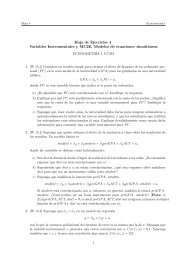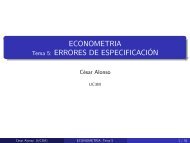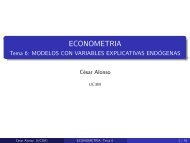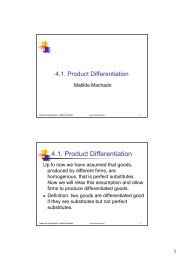Análisis de Regresión Múltiple: Estimación - Universidad Carlos III ...
Análisis de Regresión Múltiple: Estimación - Universidad Carlos III ...
Análisis de Regresión Múltiple: Estimación - Universidad Carlos III ...
Create successful ePaper yourself
Turn your PDF publications into a flip-book with our unique Google optimized e-Paper software.
<strong>Análisis</strong> <strong>de</strong> <strong>Regresión</strong> <strong>Múltiple</strong>: <strong>Estimación</strong><br />
<strong>Carlos</strong> Velasco 1<br />
1 Departamento <strong>de</strong> Economía<br />
<strong>Universidad</strong> <strong>Carlos</strong> <strong>III</strong> <strong>de</strong> Madrid<br />
Econometría I<br />
Máster en Economía Industrial<br />
<strong>Universidad</strong> <strong>Carlos</strong> <strong>III</strong> <strong>de</strong> Madrid<br />
Curso 2007/08<br />
C Velasco (MEI, UC3M) <strong>Análisis</strong> <strong>de</strong> <strong>Regresión</strong> <strong>Múltiple</strong>: <strong>Estimación</strong> UC3M, 2006 1 / 67
Resumen<br />
1 Motivación para la regresión múltiple<br />
2 Mecánica e Interpretación <strong>de</strong> Mínimos Cuadrados Ordinarios<br />
3 Valor esperado <strong>de</strong> los Estimadores MCO<br />
4 Varianza <strong>de</strong> los Estimadores MCO<br />
5 Eficiencia <strong>de</strong> MCO: Teorema <strong>de</strong> Gauss-Markov<br />
C Velasco (MEI, UC3M) <strong>Análisis</strong> <strong>de</strong> <strong>Regresión</strong> <strong>Múltiple</strong>: <strong>Estimación</strong> UC3M, 2006 2 / 67
Limitaciones <strong>de</strong>l <strong>Análisis</strong> <strong>de</strong> <strong>Regresión</strong> Simple<br />
Difícil extraer conclusiones ceteris paribus (justificando el<br />
supuesto RLS.3): mejor controlar más factores para hacer una<br />
análisis causal.<br />
Sólo consigue explicar una parte limitada <strong>de</strong> la variabilidad <strong>de</strong> y<br />
en función <strong>de</strong> una única x.<br />
Sólo pue<strong>de</strong> incorporar una <strong>de</strong>terminada relación funcional entre la<br />
x y la y (en función <strong>de</strong> x, logx, etc.).<br />
C Velasco (MEI, UC3M) <strong>Análisis</strong> <strong>de</strong> <strong>Regresión</strong> <strong>Múltiple</strong>: <strong>Estimación</strong> UC3M, 2006 3 / 67
Motivación para la regresión múltiple<br />
Mo<strong>de</strong>lo con dos variables in<strong>de</strong>pendientes. Ejemplo: gasto por estudiante y nota media<br />
avgscore = β0 + β1expend + β2avginc + u<br />
don<strong>de</strong> expend es el gasto por estudiante; avgscore es el resultado <strong>de</strong>l<br />
test estandarizado en la escuela secundaria y avginc es la renta<br />
familiar media.<br />
El objeto <strong>de</strong> interés para efectos <strong>de</strong> evaluación <strong>de</strong> políticas es el<br />
efecto cp <strong>de</strong> expend sobre avgscore.<br />
Este mo<strong>de</strong>lo incluye avginc para controlar su efecto sobre<br />
avgscore.<br />
Esto es importante porque avginc está correlado positivamente<br />
con el gasto por estudiante (<strong>de</strong>terminados por los impuestos<br />
locales sobre la renta y la propiedad).<br />
En RLS, avginc se incluiría en el término <strong>de</strong> error, que estaría<br />
correlado con expend, y por tanto el estimador <strong>de</strong> MCO estaría<br />
sesgado.<br />
C Velasco (MEI, UC3M) <strong>Análisis</strong> <strong>de</strong> <strong>Regresión</strong> <strong>Múltiple</strong>: <strong>Estimación</strong> UC3M, 2006 4 / 67
Motivación para la regresión múltiple<br />
Mo<strong>de</strong>lo con dos variables in<strong>de</strong>pendientes. Caso general<br />
β0 es el término constante.<br />
y = β0 + β1x1 + β2x2 + u<br />
β1 mi<strong>de</strong> el efecto sobre y <strong>de</strong> un cambio en x1, manteniendo otros<br />
factores constantes.<br />
β2 mi<strong>de</strong> el efecto sobre y <strong>de</strong> un cambio en x2, manteniendo otros<br />
factores constantes.<br />
C Velasco (MEI, UC3M) <strong>Análisis</strong> <strong>de</strong> <strong>Regresión</strong> <strong>Múltiple</strong>: <strong>Estimación</strong> UC3M, 2006 5 / 67
Motivación para la regresión múltiple<br />
Otro ejemplo<br />
Es posible que x1 y x2 estén relacionados perfectamente:<br />
cons = β0 + β1inc + β2inc 2 + u,<br />
pero no <strong>de</strong> forma lineal, don<strong>de</strong> u contiene otros factores que<br />
afectan al consumo aparte <strong>de</strong> la renta (inc).<br />
Renta es el único factor que afecta al consumo, y aparentemente<br />
un mo<strong>de</strong>lo <strong>de</strong> RLS es suficiente. Pero renta influye sobre<br />
consumo mediante dos funciones, x1 = inc y x2 = inc 2 .<br />
Mecánicamente se estima como un mo<strong>de</strong>lo <strong>de</strong> <strong>Regresión</strong> <strong>Múltiple</strong><br />
habitual, pero la interpretación <strong>de</strong> los parámetros cambia: x2 no<br />
pue<strong>de</strong> estar constante si x1 cambia.<br />
En este caso la propensión marginal a consumir es<br />
∆cons<br />
∆inc = β1 + 2β2inc<br />
Para calcular efectos parciales es importante la <strong>de</strong>finición <strong>de</strong> los<br />
regresores.<br />
C Velasco (MEI, UC3M) <strong>Análisis</strong> <strong>de</strong> <strong>Regresión</strong> <strong>Múltiple</strong>: <strong>Estimación</strong> UC3M, 2006 6 / 67
Motivación para la regresión múltiple<br />
Supuestos<br />
Generalización <strong>de</strong> RLS.3:<br />
E (u|x1, x2) = 0.<br />
El valor esperado <strong>de</strong> u <strong>de</strong>be ser igual para todas las<br />
combinaciones <strong>de</strong> x1 y x2 : implica que los otros factores que<br />
afectan a y <strong>de</strong>ben estar no relacionados (en media) con x1 y x2.<br />
EJEMPLO ecuación <strong>de</strong> salarios: los niveles medios habilidad<br />
<strong>de</strong>ben ser iguales para todas las combinaciones <strong>de</strong> educación y<br />
experiencia en la población <strong>de</strong> trabajadores.<br />
EJEMPLO resultados estudiantes: otros factores que afecten a la<br />
nota (características <strong>de</strong>l instituto o <strong>de</strong>l estudiante), NO <strong>de</strong>ben<br />
estar, en promedio, relacionados con la financiación ni con el<br />
ingreso familiar medio.<br />
EJEMPLO mo<strong>de</strong>lo cuadrático: en este caso<br />
E<br />
<br />
u|inc, inc 2<br />
= E (u|inc) = 0.<br />
C Velasco (MEI, UC3M) <strong>Análisis</strong> <strong>de</strong> <strong>Regresión</strong> <strong>Múltiple</strong>: <strong>Estimación</strong> UC3M, 2006 7 / 67
Motivación para la regresión múltiple<br />
Mo<strong>de</strong>lo con k variables in<strong>de</strong>pendientes<br />
k + 1 parámetros.<br />
y = β0 + β1x1 + β2x2 + · · · + βkxk + u<br />
β0 es el término constante.<br />
βj mi<strong>de</strong> el efecto sobre y <strong>de</strong> un cambio en xj, manteniendo otros<br />
factores constantes (parámetros <strong>de</strong> pendiente).<br />
u : otros factores que afectan y y no son x1, x2, . . . , xk.<br />
C Velasco (MEI, UC3M) <strong>Análisis</strong> <strong>de</strong> <strong>Regresión</strong> <strong>Múltiple</strong>: <strong>Estimación</strong> UC3M, 2006 8 / 67
Motivación para la regresión múltiple<br />
Mo<strong>de</strong>lo con k variables in<strong>de</strong>pendientes: EJEMPLO<br />
log (salary) = β0 + β1log (sales) + β2ceoten + β3ceoten 2 + u<br />
β1 : elasticidad cp <strong>de</strong>l salario respecto a sales.<br />
Si β3 = 0 : 100β2 es aproximadamente el porcentaje cp <strong>de</strong><br />
incremento <strong>de</strong>l salario cuando ceoten aumenta en una unidad.<br />
Si β3 = 0, la interpretación es más compleja.<br />
La ecuación es lineal en los parámetros β0, β1, . . . , β3, pero no<br />
tiene porqué serlo en las variables: log (salary) ,<br />
log(sales) , ceoten 2 .<br />
C Velasco (MEI, UC3M) <strong>Análisis</strong> <strong>de</strong> <strong>Regresión</strong> <strong>Múltiple</strong>: <strong>Estimación</strong> UC3M, 2006 9 / 67
Motivación para la regresión múltiple<br />
Mo<strong>de</strong>lo con k variables in<strong>de</strong>pendientes: SUPUESTO<br />
Generalización <strong>de</strong> RLS.3:<br />
E (u|x1, x2, . . . , xk) = 0.<br />
El valor esperado <strong>de</strong> u <strong>de</strong>be ser igual para todas las<br />
combinaciones <strong>de</strong> x1, x2, . . . , xk.<br />
También implica que se han especificado correctamente todas las<br />
relaciones funcionales entre las x ′ s y la y.<br />
Este supuesto garantiza que MCO está insesgado, y si se omite<br />
una variable <strong>de</strong> x1, x2, . . . , xk ocasionará un sesgo.<br />
C Velasco (MEI, UC3M) <strong>Análisis</strong> <strong>de</strong> <strong>Regresión</strong> <strong>Múltiple</strong>: <strong>Estimación</strong> UC3M, 2006 10 / 67
Mecánica e Interpretación <strong>de</strong> Mínimos Cuadrados<br />
Ordinarios<br />
1 Motivación para la regresión múltiple<br />
2 Mecánica e Interpretación <strong>de</strong> Mínimos Cuadrados Ordinarios<br />
3 Valor esperado <strong>de</strong> los Estimadores MCO<br />
4 Varianza <strong>de</strong> los Estimadores MCO<br />
5 Eficiencia <strong>de</strong> MCO: Teorema <strong>de</strong> Gauss-Markov<br />
C Velasco (MEI, UC3M) <strong>Análisis</strong> <strong>de</strong> <strong>Regresión</strong> <strong>Múltiple</strong>: <strong>Estimación</strong> UC3M, 2006 11 / 67
Mecánica e interpretación <strong>de</strong> Mínimos Cuadrados<br />
Ordinarios<br />
Obtención <strong>de</strong> los EMCO: Mo<strong>de</strong>los con 2 variables<br />
Ecuación estimada por MCO:<br />
ˆy = ˆβ0 + ˆβ1x1 + ˆβ2x2.<br />
MCO elige los valores <strong>de</strong> ˆβ0, ˆβ1, ˆβ2 que minimizan la suma <strong>de</strong><br />
cuadrados <strong>de</strong> los residuos.<br />
Dadas n observaciones {(xi1, xi2, yi) , i = 1, . . . , n} se eligen<br />
ˆβ0, ˆ β1, ˆ β2 para hacer<br />
n<br />
i=1<br />
tan pequeño como sea posible.<br />
<br />
2 yi − ˆβ0 − ˆβ1xi1 − ˆβ2xi2<br />
C Velasco (MEI, UC3M) <strong>Análisis</strong> <strong>de</strong> <strong>Regresión</strong> <strong>Múltiple</strong>: <strong>Estimación</strong> UC3M, 2006 12 / 67
Mecánica e interpretación <strong>de</strong> MCO<br />
Obtención <strong>de</strong> los EMCO: Mo<strong>de</strong>los con 2 variables (2)<br />
xij : i -th observación <strong>de</strong> la variable j, i = 1, . . . , n; j = 1, . . . , k.<br />
xi1, xi2 : 1,2, nombre <strong>de</strong> la variable.<br />
xi1 = educi; xi2 = experi.<br />
C Velasco (MEI, UC3M) <strong>Análisis</strong> <strong>de</strong> <strong>Regresión</strong> <strong>Múltiple</strong>: <strong>Estimación</strong> UC3M, 2006 13 / 67
Mecánica e interpretación <strong>de</strong> MCO<br />
Obtención <strong>de</strong> los EMCO: caso general<br />
Ecuación estimada por MCO:<br />
ˆy = ˆβ0 + ˆβ1x1 + ˆβ2x2 + · · · + ˆβkxk.<br />
MCO elige los valores <strong>de</strong> ˆβ0, ˆβ1, ˆβ2, . . . , ˆβk que minimizan la suma<br />
<strong>de</strong> cuadrados <strong>de</strong> los residuos.<br />
Dadas n observaciones {(xi1, xi2, . . . , xik, yi) , i = 1, . . . , n} se<br />
eligen ˆ β0, ˆ β1, ˆ β2 . . . , ˆ βk para hacer<br />
n<br />
i=1<br />
<br />
2 yi − ˆβ0 − ˆβ1xi1 − ˆβ2xi2 − · · · − ˆβkxik<br />
tan pequeño como sea posible.<br />
C Velasco (MEI, UC3M) <strong>Análisis</strong> <strong>de</strong> <strong>Regresión</strong> <strong>Múltiple</strong>: <strong>Estimación</strong> UC3M, 2006 14 / 67
Mecánica e interpretación <strong>de</strong> MCO<br />
Obtención <strong>de</strong> los EMCO: caso general<br />
Condiciones <strong>de</strong> primer or<strong>de</strong>n:<br />
n<br />
i=1<br />
n<br />
i=1<br />
n<br />
i=1<br />
xi1<br />
xik<br />
<br />
yi − ˆ β0 − ˆ β1xi1 − ˆ β2xi2 − · · · − ˆ <br />
βkxik<br />
<br />
<br />
yi − ˆβ0 − ˆβ1xi1 − ˆβ2xi2 − · · · − ˆβkxik<br />
.<br />
<br />
<br />
yi − ˆβ0 − ˆβ1xi1 − ˆβ2xi2 − · · · − ˆβkxik<br />
= 0<br />
= 0<br />
.<br />
= 0.<br />
C Velasco (MEI, UC3M) <strong>Análisis</strong> <strong>de</strong> <strong>Regresión</strong> <strong>Múltiple</strong>: <strong>Estimación</strong> UC3M, 2006 15 / 67
Mecánica e interpretación <strong>de</strong> MCO<br />
Obtención <strong>de</strong> los EMCO: caso general<br />
Las condiciones <strong>de</strong> primer or<strong>de</strong>n reproducen las condiciones<br />
E (u) = 0, E xju = 0, j = 1, . . . , k,<br />
que se obtienen a partir <strong>de</strong>l supuesto E (u|x1, x2, . . . , xk) = 0.<br />
A<strong>de</strong>más <strong>de</strong>ben resolverse <strong>de</strong> forma única.<br />
<strong>Regresión</strong> mínimo cuadrática, función <strong>de</strong> regresión muestral:<br />
ˆy = ˆ β0 + ˆ β1x1 + ˆβ2x2 + · · · + ˆβkxk.<br />
ˆβ0 : estimador MCO <strong>de</strong>l término constante.<br />
ˆβ1, ˆβ2, . . . , ˆβk : estimadores MCO <strong>de</strong> las pendientes.<br />
C Velasco (MEI, UC3M) <strong>Análisis</strong> <strong>de</strong> <strong>Regresión</strong> <strong>Múltiple</strong>: <strong>Estimación</strong> UC3M, 2006 16 / 67
Mecánica e interpretación <strong>de</strong> MCO<br />
Interpretación <strong>de</strong> la ecuación estimada por MCO: 2 variables<br />
ˆy = ˆβ0 + ˆβ1x1 + ˆβ2x2<br />
ˆβ0 : valor predicho <strong>de</strong> y cuando x1 = 0 y x2 = 0.<br />
ˆβ1, ˆβ2 : interpretación ceteris paribus:<br />
∆ˆy = ˆ β1∆x1 + ˆ β2∆x2.<br />
Si ∆x2 = 0 (mantenemos x2 constante) entonces<br />
∆ˆy = ˆβ1∆x1.<br />
Si ∆x1 = 0, (mantenemos x1 constante) entonces<br />
∆ˆy = ˆβ2∆x2.<br />
C Velasco (MEI, UC3M) <strong>Análisis</strong> <strong>de</strong> <strong>Regresión</strong> <strong>Múltiple</strong>: <strong>Estimación</strong> UC3M, 2006 17 / 67
Mecánica e interpretación <strong>de</strong> MCO<br />
Ejemplo: Determinantes <strong>de</strong>l College GPA<br />
<strong>Regresión</strong> <strong>Múltiple</strong>:<br />
colGPA = β0 + β1hsGPA + β2ACT + u<br />
colGPA: college gra<strong>de</strong> point average.<br />
hsGPA : high school GPA.<br />
ACT : achievement test score.<br />
n = 141, GPA1<br />
<strong>Regresión</strong> simple:<br />
colGPA = γ0 + γ1ACT + v<br />
No permite comparar estudiantes con el mismo hsGPA!!<br />
C Velasco (MEI, UC3M) <strong>Análisis</strong> <strong>de</strong> <strong>Regresión</strong> <strong>Múltiple</strong>: <strong>Estimación</strong> UC3M, 2006 18 / 67
Mecánica e interpretación <strong>de</strong> MCO<br />
Interpretación <strong>de</strong> la ecuación estimada por MCO: caso general<br />
ˆy = ˆβ0 + ˆβ1x1 + ˆβ2x2 + · · · + ˆβkxk<br />
ˆβ0 : valor predicho <strong>de</strong> y cuando x1 = 0, . . . , xk = 0.<br />
ˆβj, j = 1, . . . , k : interpretación ceteris paribus:<br />
∆ˆy = ˆ β1∆x1 + ˆ β2∆x2 + · · · + ˆ βk∆xk.<br />
Si ∆x2 = · · · = ∆xk = 0 (mantenemos x2, . . . , xk constantes)<br />
entonces<br />
∆ˆy = ˆβ1∆x1.<br />
C Velasco (MEI, UC3M) <strong>Análisis</strong> <strong>de</strong> <strong>Regresión</strong> <strong>Múltiple</strong>: <strong>Estimación</strong> UC3M, 2006 19 / 67
Mecánica e interpretación <strong>de</strong> MCO<br />
Interpretación <strong>de</strong> la ecuación estimada por MCO. Ejemplo: ecuación <strong>de</strong> salarios<br />
log (wage) = β0 + β1educ + β2exper + β3tenure + u<br />
n = 526, WAGE1.<br />
Variable <strong>de</strong>pendiente en logaritmos: el salario aumenta en un<br />
βj · 100 % si ∆xj = 1<br />
C Velasco (MEI, UC3M) <strong>Análisis</strong> <strong>de</strong> <strong>Regresión</strong> <strong>Múltiple</strong>: <strong>Estimación</strong> UC3M, 2006 20 / 67
Mecánica e interpretación <strong>de</strong> MCO<br />
Interpretación <strong>de</strong> "Mantener Otros Factores Constantes"<br />
El análisis <strong>de</strong> regresión múltiple proporciona interpretaciones<br />
ceteris paribus incluso si los datos no se han recogido <strong>de</strong> forma<br />
ceteris paribus.<br />
No se muestrea a personas con igual hsGPA, pero posiblemente<br />
con diferentes resultados ACT .<br />
Los datos se recogen <strong>de</strong> forma aleatoria <strong>de</strong> una población sin<br />
restricciones en los valores <strong>de</strong> hsGPA o <strong>de</strong> ACT .<br />
<strong>Regresión</strong> múltiple permite realizar en situaciones no<br />
experimentales los mismos análisis que hacen otros científicos en<br />
situaciones <strong>de</strong> laboratorio bajo control.<br />
C Velasco (MEI, UC3M) <strong>Análisis</strong> <strong>de</strong> <strong>Regresión</strong> <strong>Múltiple</strong>: <strong>Estimación</strong> UC3M, 2006 21 / 67
Mecánica e interpretación <strong>de</strong> MCO<br />
Valores ajustados y Residuos MCO<br />
Valor ajustado para la observación i :<br />
Residuo para la observación i :<br />
ˆyi = ˆβ0 + ˆβ1xi1 + ˆβ2xi2 + · · · + ˆβkxik.<br />
ûi = yi − ˆyi<br />
= yi − ˆβ0 − ˆβ1xi1 − ˆβ2xi2 − · · · − ˆβkxik.<br />
C Velasco (MEI, UC3M) <strong>Análisis</strong> <strong>de</strong> <strong>Regresión</strong> <strong>Múltiple</strong>: <strong>Estimación</strong> UC3M, 2006 22 / 67
Mecánica e interpretación <strong>de</strong> MCO<br />
Propieda<strong>de</strong>s <strong>de</strong> los Valores ajustados y Residuos MCO<br />
El punto<br />
û = 0<br />
<br />
Cov n u, xj = 0, j = 1, . . . , k<br />
(¯x1, ¯x2, , . . . ¯xk, ¯y)<br />
pertenece la recta <strong>de</strong> regresión MCO.<br />
C Velasco (MEI, UC3M) <strong>Análisis</strong> <strong>de</strong> <strong>Regresión</strong> <strong>Múltiple</strong>: <strong>Estimación</strong> UC3M, 2006 23 / 67
Mecánica e interpretación <strong>de</strong> MCO<br />
Una interpretación "<strong>de</strong> filtrado"<strong>de</strong> regresión múltiple<br />
En principio no son necesarias las fórmulas para ˆβj.<br />
Caso k = 2 :<br />
ˆβ1 =<br />
n i=1 ˆri1yi<br />
n ˆr 2<br />
i=1 i1<br />
don<strong>de</strong> ˆri1 son los residuos MCO <strong>de</strong> una regresión simple <strong>de</strong> x1 sobre<br />
x2, con la misma muestra.<br />
1 Regresamos la variable x1 sobre la variable x2.<br />
Obtenemos los residuos ˆr1 (la parte <strong>de</strong> x1 que no pue<strong>de</strong> ser<br />
explicada por x2, incorrelada con x2) : ˆr1 es la parte <strong>de</strong> x1 filtrada<br />
<strong>de</strong> x2.<br />
2 Regresamos y sobre los residuos ˆr1, lo que nos dará el efecto<br />
parcial <strong>de</strong> x1 sobre y, corregido por x2.<br />
(Como ˆri1 tienen media cero, ˆβ1 es equivalente a una regresión<br />
habitual con constante).<br />
C Velasco (MEI, UC3M) <strong>Análisis</strong> <strong>de</strong> <strong>Regresión</strong> <strong>Múltiple</strong>: <strong>Estimación</strong> UC3M, 2006 24 / 67<br />
,
Mecánica e interpretación <strong>de</strong> MCO<br />
Comparación <strong>de</strong> estimadores en regresión simple y múltiple<br />
Hay dos casos especiales en los que una regresión simple <strong>de</strong> y sobre<br />
x1 produce el mismo estimador MCO para x1 que una regresión<br />
múltiple sobre x1 y x2, es <strong>de</strong>cir<br />
en<br />
˜β1 = ˆβ1<br />
˜y = ˜β0 + ˜β1x1<br />
ˆy = ˆβ0 + ˆβ1x1 + ˆβ2x2.<br />
1 El efecto parcial <strong>de</strong> x2 sobre y es cero en la muestra, es <strong>de</strong>cir<br />
ˆβ2 = 0 [iguales condiciones <strong>de</strong> primer or<strong>de</strong>n].<br />
2 x1 y x2 están incorreladas en la muestra [el filtrado no tiene<br />
efecto].<br />
C Velasco (MEI, UC3M) <strong>Análisis</strong> <strong>de</strong> <strong>Regresión</strong> <strong>Múltiple</strong>: <strong>Estimación</strong> UC3M, 2006 25 / 67
Mecánica e interpretación <strong>de</strong> MCO<br />
Comparación <strong>de</strong> regresión simple y múltiple: Ejemplo<br />
Participación en Planes <strong>de</strong> Pensiones 401(k) (401K)<br />
prate = β0 + β1mrate + β2age + u<br />
don<strong>de</strong> prate es la tasa <strong>de</strong> participación y mrate es la tasa match, que<br />
es la parte <strong>de</strong>l plan que contribuye la empresa (la otra parte la cubre el<br />
trabajador). age es la edad <strong>de</strong>l plan <strong>de</strong> pensiones.<br />
¿Qué ocurre si no controlamos por age? Depen<strong>de</strong>rá <strong>de</strong> la correlación<br />
entre mrate y age.<br />
C Velasco (MEI, UC3M) <strong>Análisis</strong> <strong>de</strong> <strong>Regresión</strong> <strong>Múltiple</strong>: <strong>Estimación</strong> UC3M, 2006 26 / 67
Mecánica e interpretación <strong>de</strong> MCO<br />
Bondad <strong>de</strong> ajuste<br />
Suma <strong>de</strong> Cuadrados Totales, SST:<br />
n<br />
(yi − ¯y) 2 .<br />
i=1<br />
Suma <strong>de</strong> Cuadrados Explicada, SSE:<br />
n<br />
(ˆyi − ¯y) 2 .<br />
i=1<br />
Suma <strong>de</strong> Cuadrados <strong>de</strong> los Residuos, SSR:<br />
n<br />
û 2 i .<br />
i=1<br />
C Velasco (MEI, UC3M) <strong>Análisis</strong> <strong>de</strong> <strong>Regresión</strong> <strong>Múltiple</strong>: <strong>Estimación</strong> UC3M, 2006 27 / 67
Bondad <strong>de</strong> ajuste<br />
Descomposición <strong>de</strong> las Sumas <strong>de</strong> Cuadrados<br />
SST = SSE + SSR.<br />
Coeficiente <strong>de</strong> Determinación or R-cuadrado<br />
R 2 = SSE<br />
SST<br />
Propiedad, recordando que ˆy = ¯y,<br />
R 2 = ˆρ 2<br />
y,ˆy =<br />
= 1 − SSR<br />
SST<br />
n i=1 (yi − ¯y) (ˆyi − ¯y) 2 n i=1 (yi − ¯y) 2 n i=1 (ˆyi − ¯y) 2.<br />
R 2 nunca <strong>de</strong>scien<strong>de</strong> cuando se aña<strong>de</strong> una nueva variable en la<br />
regresión: no es un buen criterio para <strong>de</strong>cidir si añadir una nueva<br />
variable al mo<strong>de</strong>lo.<br />
C Velasco (MEI, UC3M) <strong>Análisis</strong> <strong>de</strong> <strong>Regresión</strong> <strong>Múltiple</strong>: <strong>Estimación</strong> UC3M, 2006 28 / 67
Bondad <strong>de</strong> ajuste<br />
Ejemplos<br />
Ejemplo: College GPA (GAP1)<br />
colGPA = β0 + β1hsGPA + β2ACT + u.<br />
Ejemplo: Arrestos (CRIME1)<br />
narr86 = β0 + β1pcnv + β2avgsen + β3ptime86 + β4qemp86 + u<br />
C Velasco (MEI, UC3M) <strong>Análisis</strong> <strong>de</strong> <strong>Regresión</strong> <strong>Múltiple</strong>: <strong>Estimación</strong> UC3M, 2006 29 / 67
Mecánica e interpretación <strong>de</strong> MCO<br />
<strong>Regresión</strong> a través <strong>de</strong>l origen<br />
A veces una teoría económica o el sentido común imponen<br />
β0 = 0.<br />
Se quiere una función <strong>de</strong> regresión estimada <strong>de</strong> la forma<br />
˜y = ˜β1x1 + ˜β2x2 + · · · + ˜βkxk,<br />
por lo que si x1 = x2 = · · · = xk = 0 entonces ˜y = 0.<br />
En este caso MCO minimiza<br />
n <br />
yi − ˜ β1xi1 − · · · − ˜ 2 βkxik .<br />
i=1<br />
El ajuste MCO no satisface las mismas condiciones que en el<br />
caso general:<br />
û no tienen media cero.<br />
Si <strong>de</strong>finimos R 2 = 1 − SSR/SST entonces R 2 pue<strong>de</strong> ser negativo.<br />
Si β0 = 0, entonces los estimadores MCO pue<strong>de</strong>n estar sesgados.<br />
C Velasco (MEI, UC3M) <strong>Análisis</strong> <strong>de</strong> <strong>Regresión</strong> <strong>Múltiple</strong>: <strong>Estimación</strong> UC3M, 2006 30 / 67
Valor esperado <strong>de</strong> los Estimadores MCO<br />
1 Motivación para la regresión múltiple<br />
2 Mecánica e Interpretación <strong>de</strong> Mínimos Cuadrados Ordinarios<br />
3 Valor esperado <strong>de</strong> los Estimadores MCO<br />
4 Varianza <strong>de</strong> los Estimadores MCO<br />
5 Eficiencia <strong>de</strong> MCO: Teorema <strong>de</strong> Gauss-Markov<br />
C Velasco (MEI, UC3M) <strong>Análisis</strong> <strong>de</strong> <strong>Regresión</strong> <strong>Múltiple</strong>: <strong>Estimación</strong> UC3M, 2006 31 / 67
Valores esperados <strong>de</strong> los Estimadores MCO<br />
Supuestos<br />
LM.1 (Mo<strong>de</strong>lo lineal en parámetros). En el mo<strong>de</strong>lo para la población, la<br />
variable <strong>de</strong>pendiente y se relaciona con la variable in<strong>de</strong>pendiente<br />
x y el error u mediante<br />
y = β0 + β1x1 + β2x2 + · · · + βkxk + u,<br />
don<strong>de</strong> β0,β1, . . . , βk son parámetros <strong>de</strong>sconocidos y u es una<br />
perturbación o error aleatorio.<br />
Esta expresión se la conoce como el mo<strong>de</strong>lo verda<strong>de</strong>ro (para la<br />
población) y es importante para interpretar los parámetros.<br />
C Velasco (MEI, UC3M) <strong>Análisis</strong> <strong>de</strong> <strong>Regresión</strong> <strong>Múltiple</strong>: <strong>Estimación</strong> UC3M, 2006 32 / 67
Valores esperados <strong>de</strong> los estimadores MCO<br />
Supuestos (2)<br />
LM.2 (Muestreo aleatorio). Para estimar los parámetros se dispone <strong>de</strong><br />
una muestra <strong>de</strong> tamaño n, <br />
xi1, . . . , xik,yi , i = 1, . . . , n <strong>de</strong>l mo<strong>de</strong>lo<br />
poblacional,<br />
yi = β0 + β1xi1 + β2xi2 + · · · + βkxik + ui, i = 1, . . . , n.<br />
Esta expresión es importante para <strong>de</strong>ducir las propieda<strong>de</strong>s <strong>de</strong> los<br />
EMCO <strong>de</strong> β0,β1, . . . , βk.<br />
C Velasco (MEI, UC3M) <strong>Análisis</strong> <strong>de</strong> <strong>Regresión</strong> <strong>Múltiple</strong>: <strong>Estimación</strong> UC3M, 2006 33 / 67
Valores esperados <strong>de</strong> los estimadores MCO<br />
Supuestos (3)<br />
LM.3 (Media Condicional cero).<br />
E (u|x1, x2, . . . , xk) = 0.<br />
Este supuesto pue<strong>de</strong> fallar si se especifica incorrectamente la<br />
forma funcional, por ejemplo se omite una variable que <strong>de</strong>bía<br />
estar en el mo<strong>de</strong>lo o aparece en niveles cuando <strong>de</strong>bía estar en<br />
logaritmos.<br />
También afecta a RLM.3 omitir un factor importante que está<br />
correlado con x1, x2, . . . , xk.<br />
Otros problemas son los errores <strong>de</strong> medida, y la simultaneidad (y<br />
se <strong>de</strong>termina conjuntamente con alguna variable explicativa.).<br />
Si RLM.3 es cierta, se dice que tenemos variables explicativas<br />
exógenas, y en caso contrario endógenas.<br />
C Velasco (MEI, UC3M) <strong>Análisis</strong> <strong>de</strong> <strong>Regresión</strong> <strong>Múltiple</strong>: <strong>Estimación</strong> UC3M, 2006 34 / 67
Valores esperados <strong>de</strong> los estimadores MCO<br />
Supuestos (4)<br />
LM.4 (No multicolinealidad perfecta). En la muestra (y por tanto en la<br />
población), ninguna <strong>de</strong> las variables explicativas es constante, y<br />
no hay una relación lineal exacta entre las variables explicativas.<br />
Sólo afecta a las x ′ s, por lo que es muy diferente <strong>de</strong> RLM.3.<br />
Es más compleja que RLS.4 porque afecta a las relación entre<br />
todas las variables explicativas.<br />
Si una variable in<strong>de</strong>pendiente es una combinación lineal exacta<br />
<strong>de</strong> otras variables in<strong>de</strong>pendientes, entonces hay multicolinealidad<br />
perfecta: no se pue<strong>de</strong> hacer MCO.<br />
No impi<strong>de</strong> que haya correlación entre las x ′ s, sólo requiere que<br />
no sea perfecta.<br />
C Velasco (MEI, UC3M) <strong>Análisis</strong> <strong>de</strong> <strong>Regresión</strong> <strong>Múltiple</strong>: <strong>Estimación</strong> UC3M, 2006 35 / 67
Valores esperados <strong>de</strong> los estimadores MCO<br />
Multicolinealidad. Ejemplo: test scores<br />
avgscore = β0 + β1 expend + β2avginc + u<br />
Esperamos que expend (gastos en educación) esté relacionado<br />
con avginc (renta familiar media), ya que los distritos con mayor<br />
nivel <strong>de</strong> renta tien<strong>de</strong>n a gastar más dinero por alumno.<br />
La i<strong>de</strong>a es precisamente incluir avginc precisamente porque<br />
estaría correlado con expend.<br />
Sin embargo, es extraño encontrar una muestra don<strong>de</strong> expend<br />
esté perfectamente correlado con avginc.<br />
C Velasco (MEI, UC3M) <strong>Análisis</strong> <strong>de</strong> <strong>Regresión</strong> <strong>Múltiple</strong>: <strong>Estimación</strong> UC3M, 2006 36 / 67
Valores esperados <strong>de</strong> los estimadores MCO<br />
Multicolinealidad. Causas<br />
Una variable es un múltiplo <strong>de</strong> otra: se incluyen dos variables<br />
sobre la misma magnitud en distintas unida<strong>de</strong>s.<br />
Aunque funciones <strong>de</strong> un mismo regresor aparezcan en la<br />
ecuación eso no implica multicolinealidad: x y x 2 están<br />
perfectamente relacionadas, pero no perfectamente relacionadas<br />
linealmente.<br />
En cambio tendremos problemas en<br />
pero no en<br />
log (cons) = β0 + β1 log (inc) + β2 log<br />
<br />
inc 2<br />
+ u<br />
log (cons) = β0 + β1 log (inc) + β2 [log (inc)] 2 + u.<br />
C Velasco (MEI, UC3M) <strong>Análisis</strong> <strong>de</strong> <strong>Regresión</strong> <strong>Múltiple</strong>: <strong>Estimación</strong> UC3M, 2006 37 / 67
Valores esperados <strong>de</strong> los estimadores MCO<br />
Multicolinealidad. Causas (2)<br />
También hay problemas en<br />
voteA = β0 + β1expendA + β2expendB + β3totexpend + u<br />
porque x3 = x1 + x2.<br />
En todos estos casos no se pue<strong>de</strong>n calcular los estimadores<br />
MCO.<br />
Solución: especificar con cuidado el mo<strong>de</strong>lo: eliminar la(s)<br />
variable(s) redundante(s).<br />
Otra causa: el tamaño muestral n es <strong>de</strong>masiado pequeño,<br />
n < k + 1.<br />
C Velasco (MEI, UC3M) <strong>Análisis</strong> <strong>de</strong> <strong>Regresión</strong> <strong>Múltiple</strong>: <strong>Estimación</strong> UC3M, 2006 38 / 67
Valores esperados <strong>de</strong> los estimadores MCO<br />
Teorema 3.1 (Insesga<strong>de</strong>z <strong>de</strong> MCO). Bajo los supuestos RLM.1.-5<br />
<br />
E ˆβj = βj, j = 0, . . . , k,<br />
para cualquier valor <strong>de</strong> los parámetros poblacionales βj.<br />
El supuesto clave es RLM.3<br />
La propiedad <strong>de</strong> insesga<strong>de</strong>z no dice nada sobre el resultado <strong>de</strong> la<br />
estimación en un caso particular, si no que es una propiedad <strong>de</strong>l<br />
método <strong>de</strong> estimación MCO.<br />
C Velasco (MEI, UC3M) <strong>Análisis</strong> <strong>de</strong> <strong>Regresión</strong> <strong>Múltiple</strong>: <strong>Estimación</strong> UC3M, 2006 39 / 67
Valores esperados <strong>de</strong> los estimadores MCO<br />
Inclusión <strong>de</strong> variables irrelevantes en un mo<strong>de</strong>lo <strong>de</strong> regresión<br />
O sobre-especificación <strong>de</strong>l mo<strong>de</strong>lo <strong>de</strong> regresión múltiple:<br />
y = β0 + β1x1 + β2x2 + β3x3 + u<br />
con los supuestos RLM.1-4.<br />
Sin embargo x3 no tiene efecto sobre y, una vez que se<br />
consi<strong>de</strong>ran x1 y x2, por lo que β3 = 0,<br />
E (y|x1, x2, x3) = E (y|x1, x2) = β0 + β1x1 + β2x2.<br />
No se sabe que β3 = 0 : se incluye x3 en la ecuación estimada,<br />
ˆy = ˆβ0 + ˆβ1x1 + ˆβ2x2 + ˆβ3x3.<br />
¿Cuál es el efecto sobre la insesga<strong>de</strong>z <strong>de</strong> ˆβ1 y ˆβ2? NINGUNO.<br />
El Teorema 3.1 es<br />
<br />
válido<br />
<br />
para cualquier valor <strong>de</strong> βj, incluyendo<br />
βj = 0. A<strong>de</strong>más E ˆβ3 = β3 = 0.<br />
¿Cuál es el efecto entonces sobre la estimación MCO?<br />
C Velasco (MEI, UC3M) <strong>Análisis</strong> <strong>de</strong> <strong>Regresión</strong> <strong>Múltiple</strong>: <strong>Estimación</strong> UC3M, 2006 40 / 67
Valores esperados <strong>de</strong> los estimadores MCO<br />
Sesgo por omisión <strong>de</strong> variables: el caso simple<br />
Ahora se omite una variable que sí que pertenece al mo<strong>de</strong>lo<br />
poblacional: se excluye una variable relevante o infra-estimación<br />
<strong>de</strong>l mo<strong>de</strong>lo: caso particular <strong>de</strong> error <strong>de</strong> especificación.<br />
◮ Esto conllevará un sesgo en los estimadores MCO.<br />
Mo<strong>de</strong>lo verda<strong>de</strong>ro:<br />
y = β0 + β1x1 + β2x2 + u<br />
y se satisfacen RLM.1-4.<br />
Suponemos que el objeto <strong>de</strong> interés es β1, el efecto parcial <strong>de</strong> x1<br />
sobre y.<br />
Para obtener estimadores insesgados <strong>de</strong>beríamos incluir x2 en la<br />
regresión, pero no lo hacemos,<br />
˜y = ˜β0 + ˜β1x1.<br />
C Velasco (MEI, UC3M) <strong>Análisis</strong> <strong>de</strong> <strong>Regresión</strong> <strong>Múltiple</strong>: <strong>Estimación</strong> UC3M, 2006 41 / 67
Valores esperados <strong>de</strong> los estimadores MCO<br />
Sesgo por omisión <strong>de</strong> variables: Ejemplo<br />
Mo<strong>de</strong>lo verda<strong>de</strong>ro:<br />
Mo<strong>de</strong>lo estimado:<br />
wage = β0 + β1educ + β2abil + u.<br />
wage = β0 + β1educ + v,<br />
don<strong>de</strong> v = β2abil + u, y el estimador <strong>de</strong> β1 en este mo<strong>de</strong>lo es ˜β1.<br />
C Velasco (MEI, UC3M) <strong>Análisis</strong> <strong>de</strong> <strong>Regresión</strong> <strong>Múltiple</strong>: <strong>Estimación</strong> UC3M, 2006 42 / 67
Valores esperados <strong>de</strong> los estimadores MCO<br />
Sesgo por omisión <strong>de</strong> variables: el caso simple (2)<br />
Deducción <strong>de</strong>l valor esperado <strong>de</strong> ˜β1 (regresión simple):<br />
Ahora sustituimos<br />
y obtenemos<br />
˜β1 =<br />
n<br />
i=1 (xi1 − ¯x1) yi<br />
n i=1 (xi1 − ¯x1)<br />
2 .<br />
yi = β0 + β1xi1 + β2xi2 + ui<br />
n<br />
(xi1 − ¯x1) (β0 + β1xi1 + β2xi2 + ui)<br />
i=1<br />
= β1<br />
i=1<br />
n<br />
(xi1 − ¯x1) 2 + β2<br />
n<br />
(xi1 − ¯x1) xi2 +<br />
i=1<br />
n<br />
(xi1 − ¯x1) ui.<br />
C Velasco (MEI, UC3M) <strong>Análisis</strong> <strong>de</strong> <strong>Regresión</strong> <strong>Múltiple</strong>: <strong>Estimación</strong> UC3M, 2006 43 / 67<br />
i=1
Valores esperados <strong>de</strong> los estimadores MCO<br />
Sesgo por omisión <strong>de</strong> variables: el caso simple (2)<br />
Por tanto, usando que E (ui) = 0,<br />
n E ˜β1<br />
i=1 = β1 + β2<br />
(xi1 − ¯x1) xi2<br />
n i=1 (xi1 − ¯x1)<br />
por lo que en general ˜β1 está sesgado para estimar β1.<br />
El cociente que multiplica β2 es el coeficiente <strong>de</strong> la pendiente <strong>de</strong><br />
la regresión <strong>de</strong> x2 sobre x1, usando la misma muestra:<br />
y por tanto<br />
E<br />
˜x2 = ˜ δ0 + ˜ δ1x1,<br />
<br />
˜β1 = β1 + β2 ˜δ1<br />
2 ,<br />
y el sesgo <strong>de</strong> variables omitidas es:<br />
<br />
Sesgo ˜β1 = E ˜β1 − β1 = β2 ˜δ1.<br />
C Velasco (MEI, UC3M) <strong>Análisis</strong> <strong>de</strong> <strong>Regresión</strong> <strong>Múltiple</strong>: <strong>Estimación</strong> UC3M, 2006 44 / 67
Valores esperados <strong>de</strong> los estimadores MCO<br />
Sesgo por omisión <strong>de</strong> variables: el caso simple (3)<br />
Hay dos casos en los que ˜β1 es insesgado:<br />
1 Si β2 = 0, por lo que x2 no aparece en la ecuación.<br />
2 Si ˜δ1 = 0, es <strong>de</strong>cir la covarianza muestral entre x1 y x2 es cero.<br />
Ya sabemos que si x1 y x2 están incorrelados muestralmente,<br />
ˆβ1 = ˜β1, y ˆβ1 es insesgado.<br />
[Sin condicionar en xi2 ˜β1 es insesgado si E (x2|x1) = E (x2) .]<br />
C Velasco (MEI, UC3M) <strong>Análisis</strong> <strong>de</strong> <strong>Regresión</strong> <strong>Múltiple</strong>: <strong>Estimación</strong> UC3M, 2006 45 / 67
Valores esperados <strong>de</strong> los estimadores MCO<br />
Sesgo por omisión <strong>de</strong> variables: el caso simple (4)<br />
Signo <strong>de</strong>l sesgo:<br />
Sesgo<br />
<br />
˜β1 = E ˜β1 − β1 = β2 ˜δ1.<br />
Corr(x1, x2) > 0 Corr(x1, x2) < 0<br />
β2 > 0 sesgo positivo sesgo negativo<br />
β2 < 0 sesgo negativo sesgo positivo<br />
En general es posible tener i<strong>de</strong>a <strong>de</strong>l signo <strong>de</strong> β2, aunque a veces es<br />
más difícil conocer el <strong>de</strong> Corr(x1, x2) .<br />
<br />
Sesgo positivo, E ˜β1 > β1, sesgo hacia arriba, sobre-estima en<br />
media.<br />
<br />
Sesgo negativo, E ˜β1 < β1, sesgo hacia abajo, infra-estima en<br />
media.<br />
C Velasco (MEI, UC3M) <strong>Análisis</strong> <strong>de</strong> <strong>Regresión</strong> <strong>Múltiple</strong>: <strong>Estimación</strong> UC3M, 2006 46 / 67
Valores esperados <strong>de</strong> los estimadores MCO<br />
Sesgo por omisión <strong>de</strong> variables: Ejemplo, ecuación salarial<br />
WAGE1, n = 526<br />
log (wage) = β0 + β1educ + β2abil + u.<br />
Si omitimos abil porque no tenemos datos:<br />
Po<strong>de</strong>mos esperar que β2 > 0.<br />
Y que Corr(x1, x2) > 0.<br />
Por lo que el sesgo será positivo: ˜β1 sobreestimará en media el<br />
efecto parcial <strong>de</strong> educación (porque también incluye el efecto<br />
parcial <strong>de</strong> abil).<br />
C Velasco (MEI, UC3M) <strong>Análisis</strong> <strong>de</strong> <strong>Regresión</strong> <strong>Múltiple</strong>: <strong>Estimación</strong> UC3M, 2006 47 / 67
Valores esperados <strong>de</strong> los estimadores MCO<br />
Sesgo por omisión <strong>de</strong> variables: Ejemplo, test scores<br />
avgscore = β0 + β1 expend + β2povrate + u.<br />
Si no tenemos datos sobre la tasa <strong>de</strong> pobreza, povrate,<br />
Po<strong>de</strong>mos esperar que β2 < 0.<br />
Y que Corr(x1, x2) < 0.<br />
Por lo que el sesgo será positivo.<br />
Pue<strong>de</strong> que β1 = 0, pero en una regresión simple ˜ β1 tendrá<br />
valores en media positivos y se concluirá que el efecto <strong>de</strong>l gasto<br />
es positivo.<br />
C Velasco (MEI, UC3M) <strong>Análisis</strong> <strong>de</strong> <strong>Regresión</strong> <strong>Múltiple</strong>: <strong>Estimación</strong> UC3M, 2006 48 / 67
Valores esperados <strong>de</strong> los estimadores MCO<br />
Sesgo por omisión <strong>de</strong> variables: casos más generales<br />
Obtener el signo <strong>de</strong>l sesgo cuando hay múltiples regresores es<br />
más complicado.<br />
Si se omite un sólo regresor, resulta en que todos los estimadores<br />
MCO están sesgados.<br />
Mo<strong>de</strong>lo verda<strong>de</strong>ro:<br />
y se satisfacen RLM.1-4.<br />
Se omite x3, y se ajusta<br />
y = β0 + β1x1 + β2x2 + β3x3 + u<br />
y = ˜β0 + ˜β1x1 + ˜β2x2.<br />
x2 y x3 están incorrelados, pero x1 está correlado con x3.<br />
En general ˜β1 y ˜β2 estarán sesgados (excepto cuando x1 y x2<br />
están incorrelados también).<br />
C Velasco (MEI, UC3M) <strong>Análisis</strong> <strong>de</strong> <strong>Regresión</strong> <strong>Múltiple</strong>: <strong>Estimación</strong> UC3M, 2006 49 / 67
Valores esperados <strong>de</strong> los estimadores MCO<br />
Sesgo por omisión <strong>de</strong> variables: casos más generales (2)<br />
Si x1 y x2 están incorrelados, se pue<strong>de</strong> estudiar el sesgo como si x2<br />
estuviese fuera <strong>de</strong> la regresión:<br />
E<br />
n ˜β1<br />
i=1 = β1 + β3<br />
(xi1 − ¯x1) xi3<br />
n i=1 (xi1 − ¯x1)<br />
2 ,<br />
por lo que en general ˜ β1 está sesgado para estimar β1.<br />
C Velasco (MEI, UC3M) <strong>Análisis</strong> <strong>de</strong> <strong>Regresión</strong> <strong>Múltiple</strong>: <strong>Estimación</strong> UC3M, 2006 50 / 67
Valores esperados <strong>de</strong> los estimadores MCO<br />
Sesgo por omisión <strong>de</strong> variables: Ejemplo, ecuación salarial<br />
Si omitimos abil:<br />
log (wage) = β0 + β1educ + β2exper + β3abil + u.<br />
Los EMCO <strong>de</strong> β1 y β2 cuando se omite abil estarán sesgados.<br />
Asumimos que exper y abil están incorrelados y a<strong>de</strong>más, como<br />
aproximación, que educ y exper también están incorrelados.<br />
Como β3 > 0 y educ y abil están correlados positivamente,<br />
entonces ˜β1 tendría un sesgo positivo, al igual que cuando exper<br />
no está en el mo<strong>de</strong>lo.<br />
C Velasco (MEI, UC3M) <strong>Análisis</strong> <strong>de</strong> <strong>Regresión</strong> <strong>Múltiple</strong>: <strong>Estimación</strong> UC3M, 2006 51 / 67
Varianza <strong>de</strong> los Estimadores MCO<br />
1 Motivación para la regresión múltiple<br />
2 Mecánica e Interpretación <strong>de</strong> Mínimos Cuadrados Ordinarios<br />
3 Valor esperado <strong>de</strong> los Estimadores MCO<br />
4 Varianza <strong>de</strong> los Estimadores MCO<br />
5 Eficiencia <strong>de</strong> MCO: Teorema <strong>de</strong> Gauss-Markov<br />
C Velasco (MEI, UC3M) <strong>Análisis</strong> <strong>de</strong> <strong>Regresión</strong> <strong>Múltiple</strong>: <strong>Estimación</strong> UC3M, 2006 52 / 67
Varianza <strong>de</strong> los Estimadores MCO<br />
A<strong>de</strong>más <strong>de</strong> saber que la distribución muestral <strong>de</strong> ˆβj está centrada,<br />
es importante saber su variabilidad alre<strong>de</strong>dor <strong>de</strong> βj.<br />
A<strong>de</strong>más <strong>de</strong> RLM.1-4, añadimos un nuevo supuesto para<br />
simplificar los cálculos y obtener resultados <strong>de</strong> optimalidad.<br />
LM.5 (Homocedasticidad Condicional): u tiene varianza, condicional en<br />
x1, . . . , xk constante,<br />
Var (u|x1, . . . , xk) = σ 2 .<br />
Si no se cumple, estamos en presencia <strong>de</strong> heteroscedasticidad.<br />
C Velasco (MEI, UC3M) <strong>Análisis</strong> <strong>de</strong> <strong>Regresión</strong> <strong>Múltiple</strong>: <strong>Estimación</strong> UC3M, 2006 53 / 67
Varianza <strong>de</strong> los Estimadores MCO<br />
Los supuestos RLM.1-5 se <strong>de</strong>nominan los supuestos <strong>de</strong><br />
Gauss-Markov [para datos <strong>de</strong> sección cruzada].<br />
RLM.3 y RLM.5 se pue<strong>de</strong>n escribir como, x = (x1, . . . , xk) ,<br />
E (y|x) = β0 + β1x1 + β2x2 + · · · + βkxk<br />
Var (u|x) = σ 2<br />
Es, junto con RLM.3, más débil que el supuesto <strong>de</strong><br />
in<strong>de</strong>pen<strong>de</strong>ncia.<br />
σ 2 se le llama la varianza <strong>de</strong>l error o perturbación.<br />
C Velasco (MEI, UC3M) <strong>Análisis</strong> <strong>de</strong> <strong>Regresión</strong> <strong>Múltiple</strong>: <strong>Estimación</strong> UC3M, 2006 54 / 67
Varianza <strong>de</strong> los estimadores MCO (2)<br />
Teorema 3.2 (Varianzas muestrales <strong>de</strong> los estimadores MCO <strong>de</strong> las<br />
pendientes). Bajo supuestos RLM.1-5, condicional en los valores <strong>de</strong><br />
las variables in<strong>de</strong>pendientes,<br />
don<strong>de</strong><br />
<br />
Var ˆβj =<br />
SSTj<br />
SSTj =<br />
σ 2<br />
<br />
1 − R 2 j<br />
n<br />
i=1<br />
, j = 1, . . . , k<br />
2 xij − ¯xj<br />
es la variación total <strong>de</strong> xj, y R2 j es el R-cuadrado <strong>de</strong> la regresión <strong>de</strong> xj<br />
sobre todas las <strong>de</strong>más variables in<strong>de</strong>pendientes (y el término<br />
constante).<br />
C Velasco (MEI, UC3M) <strong>Análisis</strong> <strong>de</strong> <strong>Regresión</strong> <strong>Múltiple</strong>: <strong>Estimación</strong> UC3M, 2006 55 / 67
Varianza <strong>de</strong> los estimadores MCO (3)<br />
Componentes <strong>de</strong> la Varianza<br />
Varianza <strong>de</strong>l error, σ2 <br />
: cuanto más ruido, mayor Var ˆβj .<br />
Es una propiedad <strong>de</strong> la población, no <strong>de</strong>pen<strong>de</strong> <strong>de</strong> n, y es<br />
<strong>de</strong>sconocido.<br />
La única forma <strong>de</strong> reducirlo es introducir más variables explicativas,<br />
pero eso no es siempre <strong>de</strong>seable ni posible.<br />
<br />
Variación total <strong>de</strong> xj, SSTj : cuanto mayor, menor Var ˆβj .<br />
Es difícil incrementarla, a parte <strong>de</strong> aumentar n.<br />
SSTj = 0 no está permitido por RLM.4.<br />
C Velasco (MEI, UC3M) <strong>Análisis</strong> <strong>de</strong> <strong>Regresión</strong> <strong>Múltiple</strong>: <strong>Estimación</strong> UC3M, 2006 56 / 67
Varianza <strong>de</strong> los estimadores MCO (4)<br />
Componentes <strong>de</strong> la Varianza (2)<br />
Relación lineal entre las variables in<strong>de</strong>pendientes<br />
R2 <br />
j : cuanto mayor, más alto es Var ˆβj . No aparece en<br />
regresión simple.<br />
Si R 2 j está próximo a 1, quiere <strong>de</strong>cir que xj se pue<strong>de</strong> explicar en<br />
gran parte por las otras variables in<strong>de</strong>pendientes. El caso extremo<br />
R2 j = 1 no está permitido por RLM.4.<br />
La alta correlación entre regresores se <strong>de</strong>nomina<br />
multicolinealidad.<br />
La Multicolinealidad aumenta la varianza <strong>de</strong> los EMCO, como lo<br />
hace una muestra pequeña, todo lo <strong>de</strong>más igual.<br />
Generalmente no hay más remedio que recoger más datos,<br />
porque eliminar variables conlleva introducir sesgos.<br />
C Velasco (MEI, UC3M) <strong>Análisis</strong> <strong>de</strong> <strong>Regresión</strong> <strong>Múltiple</strong>: <strong>Estimación</strong> UC3M, 2006 57 / 67
Varianza <strong>de</strong> los estimadores MCO (5)<br />
Componentes <strong>de</strong> la Varianza (3)<br />
Si hay muchos regresores correlados midiendo el mismo efecto<br />
(diversas clases <strong>de</strong> gasto en estudiantes), entonces se estimará<br />
el efecto <strong>de</strong> cada uno con alta varianza inevitablemente.<br />
Por otro lado, si en<br />
y = β0 + β1x1 + β2x2 + β3x3 + u<br />
<br />
x2 y x3 están muy correlados, entonces Var ˆβ2 y Var ˆβ3<br />
serán altas.<br />
Pero la correlación<br />
entre x2 y x3 no tendrá efecto directo sobre<br />
Var ˆβ1 :<br />
<br />
Si x1 está incorrelado con x2 y x3, entonces Var ˆβ1 = σ2 /SST1,<br />
igual que en regresión simple.<br />
Introducir muchos controles no tiene porqué afectar a la estimación<br />
<strong>de</strong>l parámetro <strong>de</strong> interés.<br />
C Velasco (MEI, UC3M) <strong>Análisis</strong> <strong>de</strong> <strong>Regresión</strong> <strong>Múltiple</strong>: <strong>Estimación</strong> UC3M, 2006 58 / 67
Varianza <strong>de</strong> los estimadores MCO (5)<br />
Componentes <strong>de</strong> la Varianza (3)<br />
Si hay muchos regresores correlados midiendo el mismo efecto<br />
(diversas clases <strong>de</strong> gasto en estudiantes), entonces se estimará<br />
el efecto <strong>de</strong> cada uno con alta varianza inevitablemente.<br />
Por otro lado, si en<br />
y = β0 + β1x1 + β2x2 + β3x3 + u<br />
<br />
x2 y x3 están muy correlados, entonces Var ˆβ2 y Var ˆβ3<br />
serán altas.<br />
Pero la correlación<br />
entre x2 y x3 no tendrá efecto directo sobre<br />
Var ˆβ1 :<br />
<br />
Si x1 está incorrelado con x2 y x3, entonces Var ˆβ1 = σ2 /SST1,<br />
igual que en regresión simple.<br />
Introducir muchos controles no tiene porqué afectar a la estimación<br />
<strong>de</strong>l parámetro <strong>de</strong> interés.<br />
C Velasco (MEI, UC3M) <strong>Análisis</strong> <strong>de</strong> <strong>Regresión</strong> <strong>Múltiple</strong>: <strong>Estimación</strong> UC3M, 2006 58 / 67
Varianza <strong>de</strong> los estimadores MCO (6)<br />
Varianzas en mo<strong>de</strong>los mal especificados<br />
Hay un tra<strong>de</strong>off entre sesgo y varianza a la hora <strong>de</strong> <strong>de</strong>cidir si incluir<br />
una variable o no en una regresión.<br />
Mo<strong>de</strong>lo verda<strong>de</strong>ro, con supuestos Gauss-Markov,<br />
Consi<strong>de</strong>ramos dos estimadores:<br />
ˆβ1, en regresión múltiple,<br />
˜β1, en regresión simple,<br />
y = β0 + β1x1 + β2x2 + u.<br />
ˆy = ˆβ0 + ˆβ1x1 + ˆβ2x2.<br />
˜y = β0 + ˜β1x1.<br />
Si β2 = 0, ˜ β1 estará sesgado, por lo que <strong>de</strong>s<strong>de</strong> el punto <strong>de</strong> vista<br />
<strong>de</strong>l sesgo, ˆβ1 será preferido.<br />
C Velasco (MEI, UC3M) <strong>Análisis</strong> <strong>de</strong> <strong>Regresión</strong> <strong>Múltiple</strong>: <strong>Estimación</strong> UC3M, 2006 59 / 67
Varianza <strong>de</strong> los estimadores MCO (7)<br />
Varianzas en mo<strong>de</strong>los mal especificados (2)<br />
Otro criterio más: varianza:<br />
por lo que<br />
Var<br />
Var<br />
<br />
ˆβ1<br />
<br />
˜β1<br />
Var<br />
=<br />
=<br />
σ 2<br />
<br />
SST1 1 − R2 1<br />
σ 2<br />
SST1<br />
<br />
˜β1 < Var ˆβ1 ,<br />
a menos que x1 y x2 estén incorrelados en la muestra (igual var).<br />
C Velasco (MEI, UC3M) <strong>Análisis</strong> <strong>de</strong> <strong>Regresión</strong> <strong>Múltiple</strong>: <strong>Estimación</strong> UC3M, 2006 60 / 67
Varianza <strong>de</strong> los estimadores MCO (8)<br />
Varianzas en mo<strong>de</strong>los mal especificados (3)<br />
◮ Si x1 y x2 NO están incorrelados:<br />
<br />
1 Si β2 = 0, ˜β1 es sesgado, ˆβ1 es insesgado y Var ˜β1 < Var<br />
2 Si β2 = 0, ˜ β1 y ˆ <br />
β1 son insesgados y Var ˜β1 < Var ˆβ1 .<br />
En caso (2) preferimos ˜ β1 : introducimos una variable irrelevante.<br />
El caso (1) es más complicado: se suele preferir ˆβ1 :<br />
<br />
ˆβ1 .<br />
Se pue<strong>de</strong> calcular el tamaño <strong>de</strong>l sesgo, pero este no se reduce al<br />
aumentar n, al contrario que Var ˆβ1 .<br />
A<strong>de</strong>más el cálculo condicional en x2 no tiene en cuenta que el<br />
tamaño <strong>de</strong>l error en el mo<strong>de</strong>lo corto será mayor (σ 2 ↑).<br />
C Velasco (MEI, UC3M) <strong>Análisis</strong> <strong>de</strong> <strong>Regresión</strong> <strong>Múltiple</strong>: <strong>Estimación</strong> UC3M, 2006 61 / 67
Varianza <strong>de</strong> los estimadores MCO (9)<br />
<strong>Estimación</strong> <strong>de</strong> σ 2<br />
σ 2 = E u 2 , por lo que un estimador insesgado <strong>de</strong> σ 2 es<br />
n −1 n<br />
i=1 u2 i .<br />
Como los errores no son observables, un primer estimador sería<br />
, pero este no es insesgado.<br />
n −1 SSR = n −1 n<br />
i=1 û2 i<br />
Los residuos ûi satisfacen k + 1 restricciones.<br />
Por tanto los residuos tienen n − k − 1 grados <strong>de</strong> libertad:<br />
n−k−1 = núm. <strong>de</strong> observaciones − núm. <strong>de</strong> parámetros estimados.<br />
El estimador insesgado <strong>de</strong> σ 2 que hace el ajuste por los grados<br />
<strong>de</strong> libertad es<br />
ˆσ 2 =<br />
1<br />
n − k − 1<br />
n<br />
i=1<br />
û 2 i<br />
= SSR<br />
n − k − 1 .<br />
C Velasco (MEI, UC3M) <strong>Análisis</strong> <strong>de</strong> <strong>Regresión</strong> <strong>Múltiple</strong>: <strong>Estimación</strong> UC3M, 2006 62 / 67
Varianza <strong>de</strong> los estimadores MCO (10)<br />
<strong>Estimación</strong> <strong>de</strong> σ 2 (2)<br />
Teorema 3.3. (<strong>Estimación</strong> insesgada <strong>de</strong> σ2 ). Bajo las condiciones <strong>de</strong><br />
Gauss-Markov RLM.1.5,<br />
<br />
E ˆσ 2<br />
= σ 2 .<br />
Estimador <strong>de</strong> σ, o error estándar <strong>de</strong> regresión, o SER,<br />
ˆσ = √ ˆσ 2 .<br />
ˆσ pue<strong>de</strong> aumentar o disminuir cuando se incluye una variable<br />
adicional en la regresión.<br />
C Velasco (MEI, UC3M) <strong>Análisis</strong> <strong>de</strong> <strong>Regresión</strong> <strong>Múltiple</strong>: <strong>Estimación</strong> UC3M, 2006 63 / 67
Varianza <strong>de</strong> los estimadores MCO (11)<br />
Errores estándar <strong>de</strong> los EMCO<br />
Desviación estándar <strong>de</strong> ˆβj :<br />
sd<br />
Error estándar <strong>de</strong> ˆβj :<br />
<br />
ˆβj =<br />
<br />
se ˆβj =<br />
σ<br />
<br />
SSTj 1 − R2 j<br />
ˆσ<br />
<br />
SSTj 1 − R2 j<br />
1/2 .<br />
1/2 .<br />
<br />
Sólo es válida en presencia <strong>de</strong> RLM.5 (hay que cambiar sd ˆβj y<br />
<br />
se ˆβj ).<br />
C Velasco (MEI, UC3M) <strong>Análisis</strong> <strong>de</strong> <strong>Regresión</strong> <strong>Múltiple</strong>: <strong>Estimación</strong> UC3M, 2006 64 / 67
Eficiencia <strong>de</strong> MCO: Teorema <strong>de</strong> Gauss-Markov<br />
1 Motivación para la regresión múltiple<br />
2 Mecánica e Interpretación <strong>de</strong> Mínimos Cuadrados Ordinarios<br />
3 Valor esperado <strong>de</strong> los Estimadores MCO<br />
4 Varianza <strong>de</strong> los Estimadores MCO<br />
5 Eficiencia <strong>de</strong> MCO: Teorema <strong>de</strong> Gauss-Markov<br />
C Velasco (MEI, UC3M) <strong>Análisis</strong> <strong>de</strong> <strong>Regresión</strong> <strong>Múltiple</strong>: <strong>Estimación</strong> UC3M, 2006 65 / 67
Eficiencia <strong>de</strong> MCO: Teorema <strong>de</strong> Gauss-Markov<br />
Justifica la utilización <strong>de</strong> MCO sobre otros métodos <strong>de</strong> estimación.<br />
Una justificación <strong>de</strong> MCO: es insesgado bajo RLM.1-4.<br />
Si limitamos la clase <strong>de</strong> estimadores competidores, entonces<br />
MCO es el mejor.<br />
Bajo RLM.1-5, el estimador ˆβj <strong>de</strong> βj será el estimador lineal<br />
insesgado óptimo (ELIO, BLUE).<br />
Estimador: regla que se aplica a una muestra para producir una<br />
estimación.<br />
Lineal:<br />
n<br />
˜βj =<br />
i=1<br />
wijyi<br />
don<strong>de</strong> wij pue<strong>de</strong> ser una función <strong>de</strong> los valores muestrales <strong>de</strong><br />
todas la variables in<strong>de</strong>pendientes.<br />
Insesgado: E ˆβj = βj.<br />
Óptimo: <strong>de</strong> menor varianza.<br />
C Velasco (MEI, UC3M) <strong>Análisis</strong> <strong>de</strong> <strong>Regresión</strong> <strong>Múltiple</strong>: <strong>Estimación</strong> UC3M, 2006 66 / 67
Teorema <strong>de</strong> Gauss-Markov<br />
Teorema 3.4. (Teorema <strong>de</strong> Gauss-Markov). Bajo los supuestos<br />
RLM.1-5, ˆ β0, ˆ β1, . . . , ˆ βk son los estimadores lineales insesgados<br />
óptimos (ELIOs) <strong>de</strong> β0, β1, . . . , βk, respectivamente.<br />
Si los supuestos habituales se cumplen en un problema dado, no<br />
necesitamos consi<strong>de</strong>rar ningún estimador insesgado <strong>de</strong> la forma ˜βj,<br />
MCO es el mejor.<br />
Si algún supuesto falla, entonces G-M no se cumple:<br />
Si falla RLM.3, entonces los EMCO <strong>de</strong>jan <strong>de</strong> ser insesgados.<br />
Si falla RLM.5, entonces hay estimadores lineales insesgados con<br />
menor varianza que MCO en presencia <strong>de</strong> heterocedasticidad<br />
(MCG).<br />
C Velasco (MEI, UC3M) <strong>Análisis</strong> <strong>de</strong> <strong>Regresión</strong> <strong>Múltiple</strong>: <strong>Estimación</strong> UC3M, 2006 67 / 67



